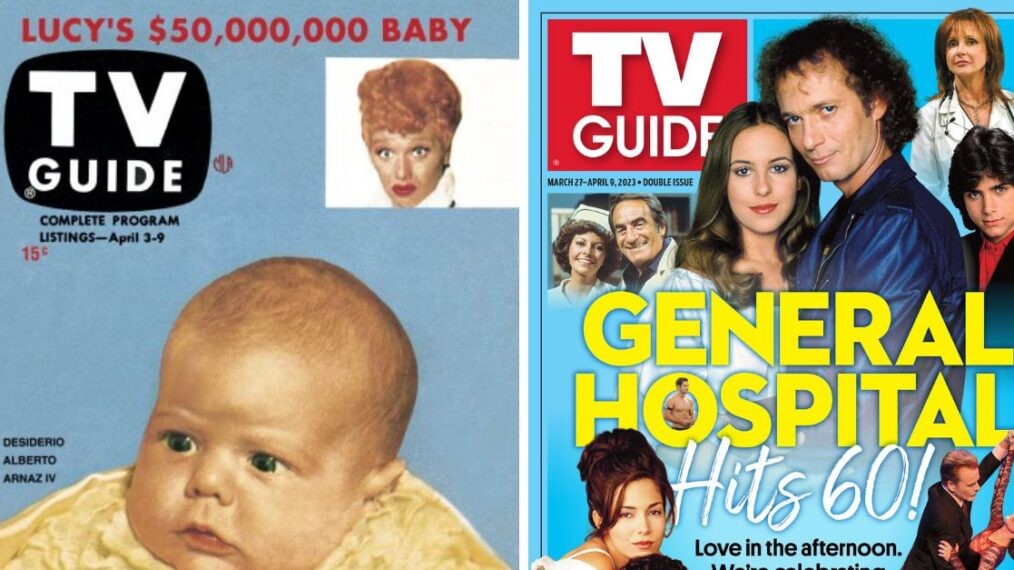Are Tv Guides Worth Money? Discover their value and collectibility in this comprehensive guide. CONDUCT.EDU.VN explores the factors influencing TV guide values and provides insights for collectors. Explore the world of vintage television collectibles and nostalgic publications.
1. The Enduring Appeal of TV Guides: A Nostalgic Collectible
The TV Guide Magazine, once a ubiquitous presence in American homes, served as the primary source for television schedules and program information. Before the advent of digital television guides and streaming services, the TV Guide was essential for planning viewing habits and discovering new shows. Its cultural significance has cemented its place as a nostalgic collectible, sparking interest among enthusiasts and collectors. The magazine’s historical relevance and association with iconic television moments contribute to its appeal, making vintage copies highly sought after. Explore the captivating history of television programming.
2. Factors Influencing TV Guide Value: Rarity, Condition, and Content
Several factors determine the value of a TV Guide, including rarity, condition, and content. Rare issues, such as the first national edition featuring Lucille Ball and Desi Arnaz Jr., command higher prices due to their historical significance and limited availability. The condition of the magazine is also critical, with well-preserved copies fetching more than those with wear and tear. Content-related factors, such as cover stars, special features, and significant television events, can also influence a TV Guide’s value. These elements contribute to a magazine’s desirability among collectors, impacting its market value.
3. Identifying Key Issues: First Editions and Celebrity Covers
Identifying key issues is essential for collectors seeking valuable TV Guides. First editions, like the April 3, 1953, issue featuring Lucille Ball’s son, are highly prized due to their historical importance. Celebrity covers, particularly those featuring iconic stars like Elvis Presley, Marilyn Monroe, or memorable television casts, also tend to be more valuable. Specific issues tied to landmark television events, such as the Moon Landing or Super Bowl broadcasts, can also be of interest to collectors. These factors make certain issues more desirable and potentially more valuable.
4. Price Guide: Understanding the Current Market Value of TV Guides
Determining the current market value of TV Guides requires research and familiarity with the collector’s market. Online auction sites, such as eBay, and specialized collector forums provide valuable insights into recent sales and current asking prices. Collector’s guides and price lists, such as those available through Heritage Auctions or WorthPoint, can also offer estimates based on condition and rarity. Consulting with experienced collectors or appraisers can provide additional guidance and ensure accurate valuations. Utilize these resources to gauge the market value of your TV guide collection.
5. The Most Valuable TV Guides: Rare Editions and Collectible Covers
Some TV Guides are more valuable than others due to their rarity, historical significance, or desirable content. The first national edition featuring Lucille Ball and Desi Arnaz Jr. is among the most sought-after issues, often fetching hundreds or even thousands of dollars in excellent condition. Other valuable editions include those featuring Elvis Presley, Marilyn Monroe, and the cast of popular shows like Star Trek or The Twilight Zone. Specific issues related to major television events or milestones can also command high prices among collectors.
5.1. George Reeves of Adventures of Superman
The September 25, 1953 issue featuring George Reeves from Adventures of Superman holds considerable value due to its association with a beloved television series. Collectors are often drawn to this issue because of the show’s cultural impact and Reeves’ iconic portrayal of Superman. The condition of the magazine, especially the cover, significantly influences its value, with well-preserved copies fetching higher prices.
5.2. Roy Rogers of The Roy Rogers Show
Featuring Roy Rogers from The Roy Rogers Show, the July 17, 1954, issue attracts collectors interested in Western television history. Roy Rogers was a prominent figure in the genre, and this cover captures a significant era in television. The magazine’s value is enhanced by its historical context and Rogers’ enduring popularity.
5.3. Walt Disney on Disneyland
Disney enthusiasts highly value the October 23, 1954 issue featuring Walt Disney on Disneyland. This issue is particularly collectible because it represents Disney’s foray into television and the creation of Disneyland, a cultural milestone. Collectors seek this magazine for its historical connection to Disney’s legacy.
5.4. Elvis Presley, The Plain Truth About Elvis Presley
The September 8, 1956, issue featuring Elvis Presley and titled The Plain Truth About Elvis Presley is a prized item due to Presley’s cultural significance. This magazine coincides with Presley’s rise to fame, making it highly sought after by music and pop culture collectors. Its value reflects Presley’s lasting impact on entertainment history.
5.5. Frank Sinatra’s Welcome Home Party for Elvis Presley
Collectors find the May 5, 1960, issue featuring Frank Sinatra’s Welcome Home Party for Elvis Presley particularly appealing due to the convergence of two iconic figures. This issue captures a unique moment in entertainment history, making it highly valuable. The combination of Sinatra and Presley enhances its collectibility.
5.6. Lorne Greene, Michael Landon, and Dan Blocker of Bonanza
The September 8, 1962, issue featuring Lorne Greene, Michael Landon, and Dan Blocker of Bonanza is valuable because of the show’s popularity and the actors’ fame. Bonanza was a long-running hit, and this cover is a nostalgic reminder of the show’s impact. Collectors are drawn to this issue for its connection to a beloved television series.
5.7. Don Knotts, Andy Griffith, and Jim Nabors of The Andy Griffith Show
Featuring Don Knotts, Andy Griffith, and Jim Nabors from The Andy Griffith Show, the March 21, 1964, issue is cherished for its connection to a classic television comedy. The show’s wholesome appeal and enduring popularity contribute to the magazine’s value. Collectors appreciate this issue for its nostalgic representation of American television.
5.8. Adam West of Batman
The March 26, 1966, issue featuring Adam West of Batman is highly collectible due to the show’s campy appeal and West’s iconic portrayal of the character. Batman was a cultural phenomenon, and this cover represents the show’s popularity. Collectors seek this issue for its connection to a memorable television series.
5.9. William Shatner and Leonard Nimoy of Star Trek
Featuring William Shatner and Leonard Nimoy from Star Trek, the March 4, 1967, issue is prized by science fiction enthusiasts. Star Trek has a dedicated fan base, and this cover is a significant piece of the show’s history. Collectors value this magazine for its association with a groundbreaking television series.
5.10. The cast of The Brady Bunch
Collectors find the April 4, 1970, issue featuring the cast of The Brady Bunch appealing because of the show’s enduring popularity. The Brady Bunch is a cultural touchstone, and this cover is a nostalgic reminder of the series’ impact. The magazine’s value is enhanced by its connection to a beloved family sitcom.
5.11. The cast of Emergency!
Featuring the cast of Emergency!, the August 16, 1975, issue is valued by collectors interested in 1970s television. Emergency! was a popular action-drama, and this cover is a representation of the show’s appeal. Collectors seek this issue for its nostalgic association with a memorable television series.
6. Condition is Key: Grading and Preservation Tips for TV Guides
The condition of a TV Guide significantly impacts its value, making proper grading and preservation essential. Collectors typically use a standardized grading scale, such as the one used for comic books, to assess the condition of their magazines. Factors considered include cover gloss, page quality, spine integrity, and the presence of any tears, stains, or writing. To preserve TV Guides, store them in acid-free sleeves and backing boards, away from direct sunlight and extreme temperatures. Handle them carefully to avoid damage and maintain their condition over time.
7. Where to Buy and Sell TV Guides: Auctions, Dealers, and Online Marketplaces
TV Guides can be bought and sold through various channels, each offering its advantages and disadvantages. Auctions, such as those held by Heritage Auctions or Sotheby’s, provide a platform for selling high-value or rare issues to serious collectors. Dealers specializing in vintage magazines can offer expertise and access to a network of potential buyers. Online marketplaces, such as eBay and Etsy, provide broad exposure and convenience for both buyers and sellers. Choose the channel that best suits your needs and the type of TV Guides you are dealing with.
8. The Future of TV Guide Collecting: Trends and Predictions
The future of TV Guide collecting is influenced by several trends and factors. Nostalgia for vintage television and pop culture continues to drive interest in collecting these magazines. The increasing accessibility of online resources and marketplaces has made it easier for collectors to buy, sell, and research TV Guides. The value of specific issues may fluctuate based on market demand and the emergence of new collectors. Overall, the TV Guide collecting hobby is expected to remain active and engaging for enthusiasts.
9. Beyond the Cover: The Content and Historical Significance of TV Guides
While the cover of a TV Guide often attracts attention, the content within holds significant historical and cultural value. TV Guides provide a snapshot of television programming, advertising, and cultural trends during specific eras. They offer insights into the shows, stars, and events that shaped popular culture. Researchers and historians can use TV Guides to study television history, audience preferences, and the evolution of media. Explore the rich content within TV Guides to gain a deeper understanding of their historical significance.
10. Preserving Television History: The Role of TV Guide Collectors
TV Guide collectors play a crucial role in preserving television history. By collecting, preserving, and documenting these magazines, they help ensure that future generations can access and appreciate this important cultural artifact. Collectors often share their knowledge and expertise through online forums, collector’s guides, and historical research. Their passion for TV Guides contributes to the broader understanding and appreciation of television history. Support and recognize the efforts of TV Guide collectors in preserving this valuable legacy.
Navigating the world of collecting can be challenging, especially when trying to determine the value of items like TV Guides. Many individuals face difficulties in finding reliable information and understanding the factors that influence the value of these vintage magazines. Concerns about condition assessment, market trends, and historical significance often leave collectors feeling overwhelmed. The legal and ethical considerations of acquiring and trading collectibles can also add to these challenges, making it difficult to confidently engage in the hobby.
CONDUCT.EDU.VN can help you navigate these challenges. Our resources offer detailed insights into condition grading, market analysis, and historical context, empowering you to make informed decisions. We provide access to expert guidance and up-to-date information, ensuring you can confidently manage and grow your collection. Whether you are buying, selling, or simply exploring the world of collectibles, CONDUCT.EDU.VN is your trusted source for knowledge and support.
Contact us for more information:
Address: 100 Ethics Plaza, Guideline City, CA 90210, United States
Whatsapp: +1 (707) 555-1234
Website: conduct.edu.vn
Frequently Asked Questions (FAQs)
1. What makes a TV Guide valuable?
A TV Guide’s value depends on its rarity, condition, and content. First editions, celebrity covers, and issues related to significant television events are typically more valuable.
2. How can I determine the value of my TV Guide?
Research online auction sites, consult collector’s guides, and seek advice from experienced collectors or appraisers.
3. What is the most valuable TV Guide issue?
The first national edition featuring Lucille Ball and Desi Arnaz Jr. is among the most valuable.
4. How do I preserve my TV Guides?
Store them in acid-free sleeves and backing boards, away from direct sunlight and extreme temperatures.
5. Where can I buy and sell TV Guides?
Auctions, dealers specializing in vintage magazines, and online marketplaces are all viable options.
6. How do I grade the condition of my TV Guide?
Use a standardized grading scale similar to those used for comic books, considering factors like cover gloss, page quality, and the presence of damage.
7. Are TV Guides from the 1950s more valuable?
Yes, TV Guides from the 1950s, especially those in good condition and featuring prominent figures, are often more valuable due to their rarity and historical significance.
8. Do TV Guides with local listings have less value?
The presence of local listings doesn’t necessarily decrease value. Some collectors seek out specific regional editions, adding to their collectibility.
9. What is the impact of autographs on a TV Guide’s value?
Autographs from notable celebrities featured in the TV Guide can significantly increase its value, especially if authenticated.
10. How has the digital age affected the value of TV Guides?
The digital age has increased the nostalgic value of TV Guides, as they represent a bygone era of television viewing, making vintage copies more appealing to collectors.


